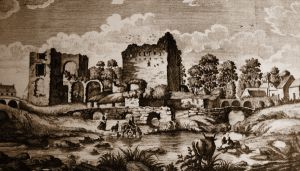Bridget Fitzgerald of Maynooth
Published in Local History Review, 2008
The most important historical commemoration this year is the four-hundred anniversary of the Flight of the Earls which occurred on 14th September 1607. There is an important county Kildare involvement in this event and the connection was centred in Maynooth Castle.
Ask anyone that has passed through the Irish educational system to name the two principal individuals involved in the Flight of the Earls and you would be informed O’Neill and O’Donnell. What occurred was a number of Irish Chieftains fled the country taking their families with them. Rory O’Donnell brought his 11-month-old son and heir but he didn’t get time to bring his pregnant wife Bridget. Bridget was a FitzGerald the daughter of the Earl of Kildare and at the time of the Flight she was in Maynooth Castle.
Bridget FitzGerald was born in 1589 in Maynooth. Her father was Henry FitzGerald the 12th Earl of Kildare. She was the granddaughter of Gerald the Wizard Earl who was the brother of the famous Silken Thomas. Bridget was actually named after St Bridget the patron saint of Kildare. In 1597 when she was 8 years old her father was killed fighting on the side of Queen Elizabeth in the ‘Nine Years War’. Four years later in 1601 when Bridget was 12 years old her Mother remarried and she was left in the care of her Grandmother Mabel Brown the Dowager Kildare. In 1605 Bridget then aged 16 married Rory O’Donnell. He was the Earl of Tyrconnell, head of the O'Donnell’s and brother of the famous Red Hugh O’Donnell.
In the Flight of the Earls episode there was an alleged plot and there is evidence that some of the plotting occurred Maynooth. Various documents suggest that Rory O’Donnell on a visit to Maynooth Castle had discussions with Richard Nugent his wife’s cousin and informed him of plans to capture Dublin Castle and kill the Lord Deputy. He also informed Nugent that Hugh O’Neill, Maguire and some of the Old English Lords of the Pale were involved in the conspiracy. Details of the plot were subsequently leaked to the Lord Deputy. The Lord Deputy who had been endeavouring for some time to obtain evidence in order to imprison O’Donnell, planned to have O’Donnell arrested as he passed through Dublin on his way to visit his wife at Maynooth. Plans were also afoot to arrest O’Neill. But the Earls were tipped off that the Government were planning to arrest them and on 14th September 1607 the Flight of the Earls took place.
Shortly afterwards, Fr. Eoghan Groome McGrath who was in the service of O’Donnell visited Bridget in Maynooth Castle. They had a secret meeting in a garden at Maynooth Castle known as the ‘Moyglare Garden’. According to tradition, this garden was on the opposite side of the Lyreen River where the ‘Mill Centre’ is today. Fr. McGrath passed on to Bridget a message and money from her husband. The money consisted of 81 pieces of gold. Bridget’s grandmother then travelled to Howth and stayed with Christopher St Laurence. He was actually the man who had tipped off the authorities about the plot. It appears at this point he attempted to play both sides and assist Bridget on leaving the country in order to join her husband on the continent. However the attempts were unsuccessful. The Lord Deputy, Chichester, then investigated her role and demanded an explanation. At this point Bridget wrote a letter to the Lord Deputy indicating that she was unaware of any plotting. Chichester in order to prevent her from leaving the country for the continent sent her to London where she met the King. An eye witness at Court gave the following account: ‘she kissed his majesty’s hand and a sweeter face you never saw. Indeed the king wondered, her husband, left so fair a face behind’. Bridget’s second child a girl was born in October 1607 and she named her after the Kings mother Mary Stuart.
Ten months after the flight in July 1608, Rory O’Donnell died from a fever in Rome. Bridget was then a widow, aged only 19 years. Their son Hugh was cared for by his aunt Nuala O’Donnell at Louvain. Later attempts aimed at getting Hugh restored to his Earldom were unsuccessful. Hugh subsequently became an officer in the army of the Spanish Netherlands and died fighting with his regiment in Spain in 1642.
As for Bridget, the King granted her an annual income of £200 and this eventually enabled her to find a suitable husband. In 1617 at the age of 28 she married 25 year-old Nicholas Barnwall of Turvey near Donabate. She had nine children by her second husband that is a total of eleven children. The couple were not without difficulties in the subsequent years. They had to flee to Wales for two years after the 1641 Rebellion. Cromwell imprisoned Nicholas in 1654 and confiscated the lands. The lands, however, were restored in 1660. Nicholas died in 1663 and was buried in the Church in Lusk. Bridget FitzGerald died in 1682 in her 93rd year and was buried beside her second husband.

